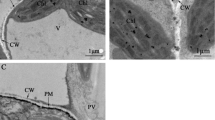Abstract
Whether rare earth elements can enter into plant cells remains controversial. This article discusses the ultracellular structural localization of lanthanum (La3+) and europium (Eu3+) in the intact plant cells fed by rare earth elements Eu3+ and La3+. Eu-TTA fluorescence analysis of the plasmalemma, cytoplast, and mitochondria showed that Eu3+ fluorescence intensities in such structures significantly increased. Eu3+ can directly enter or be carried by the artificial ion carrier A23187 into plant cells through the calcium ion (Ca2+) channel and then partially resume the synthesis of amaranthin in the Amaranthus caudatus growing in the dark. Locations of rare earth elements La3+ and Eu3+ in all kinds of components of cytoplasmatic organelles were determined with transmission electron microscope, scanning electron microscope, and energy-dispersive X-ray microanalysis. The results of energy-dispersive X-ray microanalysis indicated that Eu3+ and La3+ can be absorbed into plant cells and bind to the membranes of protoplasm, chloroplast, mitochondrion, cytoplast, and karyon. These results provide experimental evidence that rare earth elements can be absorbed into plant cells, which would be the basis for interpreting physiological and biochemical effects of rare earth elements on plant cells.
Similar content being viewed by others
References
S. Zhou, Applications of lanthanum in botanical research, Chin. Bull. Bot. 9(2), 26–29 (1992).
F. L. Zeng, Y. An, and M. F. Zhang, The effect of La(III) on the peroxidation of membrane lipids in wheat seeding leaves under osmotic stress, Biol. Trace Element Res. 69(2), 141–150 (1999).
F. L. Zeng, M. F. Zhang, S. M. Zhou, et al., The effect of lanthanide chloride on abscisic acid and electron-transport activity of some crops, Biol. Trace Element Res. 67(3), 277–284 (1999).
F. L. Zeng, Y. An, R. Li, et al., Effects of lanthanum and calcium on photoelectron transport activity and the related protein complexes in chloroplast of cucumber leaves, Biol. Trace Element Res. 77(1), 83–91 (2000).
F. L. Zeng, S. **, M. Zhang, et al., Effect of lanthanum on Ion absorption in cucumber seedling leaves, Biol. Trace Element Res. 78(3), 265–270 (2000).
T. Lettyin and W. F. Pickard, A theory of passive ion flux axon embrance, Nature 202, 1338–1339 (1964).
Z. Zou, J. Ni, Z. Li, et al., Studies of micro-area distribution, sediment and influence of samarium in liver cells of rat with electron microscope and X-ray analysis, Chin. Sci. Bull. 36(2), 140 (1991).
F. Zeng, H. Wu, Y. An, et al., Study of Eu(III) metabolism in wheat cells by Eu(III)-TAA-4,7-diphenyl-2,9-dimethyl-1,10-phenanthroline system, Acta Chim. Sinica 58(8), 1063–1066 (2000) (in Chinese).
F. Shi and T. Zhu, Biological inorganic chemistry (II), Rare Earth 7(4), 44 (1986).
K. Zhang, Property of wheat root cell membrane purified by discontinuous density, gradient centrifugation and double-phase partition method, Chin. Sci. Bull. 74, 827 (1988).
B. S. Serlin, S. K. Sopory, and S. I. Roux, Modulation of oat mitochondria ATPase activity by Ca2+ and phytochrome, Plant Physiol. 74, 827 (1984).
J. Zhou, X. **, and H. Zhang, Fluorimetric determination of trace amounts of Eu in ores with the system of TTA-phen-acetone, Rock Miner. Anal. 7(4), 295 (1988).
M. M. Bradford, A rapid and sensitive method for quantification of microgram quantities of protein utilizing the principle of protein-dye binding, Anal. Biochem. 72, 248–254 (1976).
Z. Tong and B. Liang, Photomodulated synthesis of amaranthin in Amaranthus caudatus seedlings, Acta Phytophysiol. Sinica 15(1), 1–5 (1989).
D. R. Hoagland and D. L. Arnon, Calis Agric. Exp. Sta. 347, 39–42 (1950).
Author information
Authors and Affiliations
Rights and permissions
About this article
Cite this article
Gao, Y., Zeng, F., Yi, A. et al. Research of the entry of rare earth elements Eu3+ and La3+ into plant cell. Biol Trace Elem Res 91, 253–265 (2003). https://doi.org/10.1385/BTER:91:3:253
Received:
Revised:
Accepted:
Issue Date:
DOI: https://doi.org/10.1385/BTER:91:3:253




